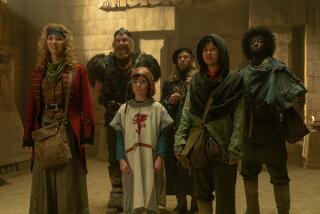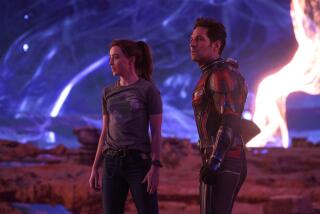‘Before Watchmen’: Did ‘Watchmen’ really need a prequel?

- Share via
Alan Moore and Dave Gibbons’ 1986-87 comic book “Watchmen” is as complete as a story can be, a beautifully complicated piece of work in which every tiny detail serves some precise purpose, sketching out decades’ worth of history for each of its characters with a few swift strokes. It was massively successful — a total game-changer for the superhero genre, and one of the bestselling graphic novels ever — and it no more demands a prequel than “The Great Gatsby” does.
It’s also an enormously lucrative piece of intellectual property, and shareholder value demands that lucrative IP be milked dry. So DC Comics has just published four “Before Watchmen” collected volumes, an elaboration on the earlier lives of “Watchmen’s” six central characters (and a few others) by an all-star crew of writers and artists. The bleeding begins almost immediately.
Moore has made it clear that he thinks “Before Watchmen” is a horrible idea — he’s referred to it as DC “soil[ing] themselves in public” — and, although Gibbons has been more diplomatic, the only trace of his work in the new material is the brittle typeface, adapted from his hand lettering in “Watchmen,” that turns up here and there. Only two veterans of the original series contributed to “Before Watchmen.” Len Wein, who edited “Watchmen,” writes the Ozymandias sequence and a brief story about the throwaway joke character Dollar Bill. Wein also scripts the first few episodes of “Curse of the Crimson Corsair,” an inchoate pirate tale otherwise written (and drawn) by “Watchmen” colorist John Higgins.
“Watchmen” was about the way the shadow of the atom bomb transformed American culture between the ‘40s and the ‘80s, the way comics responded to that cultural transformation, and the interconnectedness of the minutiae of history and culture. “Before Watchmen” is a bunch of stories about a bunch of superheroes. To paraphrase Caliph Omar’s comment on the burning of the library of Alexandria, that which agrees with “Watchmen” is redundant; that which is not contained within “Watchmen” is idiotic.
Most of J. Michael Straczynski’s story for the “Nite Owl” sequence, for instance, concerns nerdy young hero Dan Dreiberg’s fraught relationship with a sexy supervillainess, whose appearances on two pages of “Watchmen” — in a photograph and a wordless dream sequence — already said everything there is to say about that subject much more elegantly. We also learn that Dan was shaped by childhood trauma involving his father abusing his mother. Straczynski also wrote “Dr. Manhattan,” in which we learn that the big blue guy caused his own origin and was shaped by childhood trauma involving Nazis killing his mother, and “Moloch,” in which we learn that a minor player in the original story was shaped by childhood trauma involving being teased about his ears.
If it were necessary for there to be a newly produced “Rorschach” comic book, the premise of Brian Azzarello’s story — pitting Moore and Gibbons’ deranged, vicious moralist against a thinly disguised Son of Sam during New York City’s 1977 blackout — wouldn’t be a bad one, but it gets lost in gruesome plot convolutions and a way-too-cutesy cameo by a taxi driver identified in all but name as Travis Bickle. (Also, did we really need to learn where Rorschach got his “THE END IS NIGH” sign?) Azzarello and J.G. Jones’ Comedian sequence, on the other hand, is just a mess — a Gordian knot of conspiracy theories about the Kennedys and Vietnam.
Moore and Gibbons’ original “Watchmen,” though, wasn’t simply concerned with its plot and characters: at least as much of its impact as a comic book came from its formal inventiveness and brilliant commentary on its own medium and genre, and not many of the new books’ artists and writers dare to mimic that sort of structural legerdemain. The only one of the “Before Watchmen” sequences that responds to its source on the level of look-and-feel is Darwyn Cooke and Amanda Conner’s parodic Summer of Love fantasia “Silk Spectre.” That’s also why it’s the most entertaining of the bunch, despite the astonishing tastelessness of an action-comedy bit that restages panels from “Watchmen’s” rape scene.
For the most part, though, “Before Watchmen’s” artists just draw like themselves, with results that are sometimes very pretty. Jae Lee’s artwork for “Ozymandias” adapts the formal, rectilinear symmetry of Gibbons’ work to layouts based on circles, half-circles and the contours of sandblasted sculpture; the smooth, unreal perfection of Adam Hughes’ figures works nicely for the “Dr. Manhattan” sequence; Darwyn Cooke’s “Minutemen” returns to the bold brush strokes and retro iconography of his “DC: The New Frontier” series.
“Minutemen,” though, is also a direct attack on the premises of Moore’s “Watchmen.” In the original story, the superheroes of the 1940s were mostly a well-intentioned bunch, betrayed by their own frailties and the transformation of American culture, except for the venal, nihilistic Eddie Blake. Cooke’s “Minutemen” recasts them as worthless bumblers who scurry to cover up their disastrous failures, and presents Blake as a misunderstood bro who maybe goes a little too far sometimes. In other words, he’s trying to show us the dark side of a story that was already exposing the dark side of a cultural fantasy.
If the people who commissioned these comics really wanted to pay tribute to Watchmen,” perhaps they could have tried to reproduce the circumstances of its birth: giving gifted writers and artists the latitude to make something new and fresh in its tone and execution. Instead, they’ve saddled those creators with extending a groundbreaking work into a glossy but lifeless franchise.
Wolk is the author of “Reading Comics: How Graphic Novels Work and What They Mean.”
Before Watchmen
Comedian/Rorschach
Brian Azzarello, J.G. Jones and Lee Bermejo
DC: 256 pp., $29.99
Before Watchmen
Minutemen/Silk Spectre
Darwyn Cooke and Amanda Conner
DC: 288 pp., $29.99
Before Watchmen
Nite Owl/Dr. Manhattan
J. Michael Straczynski
DC: 288 pp., $29.99
Before Watchmen
Ozymandias/Crimson Corsair
Len Wein, Jae Lee and John Higgins
DC: 256 pp., $29.99
ALSO:
Neil Gaiman wants you to help him create a video game
Reza Aslan talks ‘Zealot,’ the book behind Fox News video
Obama appearance at Amazon warehouse angers booksellers
More to Read
Sign up for our Book Club newsletter
Get the latest news, events and more from the Los Angeles Times Book Club, and help us get L.A. reading and talking.
You may occasionally receive promotional content from the Los Angeles Times.







